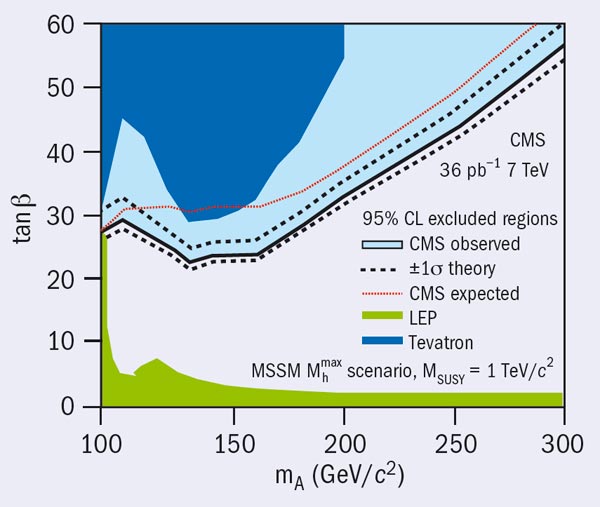
Measurements with leptons are an important tool for physics studies at the LHC. While electrons and muons – being the easiest to detect and identify – are used for many analyses, studies that include τ leptons are important for searches and for electroweak measurements in particular. It is a sign that experimental analyses are reaching maturity when physics results on τ leptons become available, as they are now doing with CMS.
The lifetime of the τ is of the order of 10–13 s, so it decays shortly after production, complicating its identification and use in physics analyses. It decays most often leptonically, into an electron or muon plus two neutrinos, or hadronically to either one or three charged particles together with neutral hadrons and a neutrino. The hadronic decays of the τ thus contain collimated low-multiplicity jets, a feature that is used experimentally to select τ decays, while reducing background from QCD jets.
CMS recently published two physics papers studying decays into τ leptons. The first presents a study of the decay of Z bosons into τ pairs, using both leptonic and hadronic decays of the τ (CMS collaboration 2011a). The τ leptons are identified via isolated groups of particles, found through the CMS particle-flow event reconstruction, that are compatible with the possible τ decays. Figure 1 shows the visible invariant mass of the two τ candidates for a τ pair, where one decays leptonically to a muon and the other decays hadronically. Because of the escaping neutrinos in the τ decays the reconstructed Z boson mass is not at its known value, but the result of the measurement agrees well with the expectation from the Monte Carlo simulation.

This yields a cross-section for Z → ττ, in proton–proton collisions at 7 TeV, of 1.00 ± 0.05 (stat.) ± 0.08 (syst.) ± 0.04 (lumi.) nb. This agrees well with similar cross-sections measured in the electron and muon decay modes of the Z – as is expected from the lepton universality in Z decays that was established in precision measurements by experiments in the 1990s at the Large Electron Positron collider.
More interestingly, the τ can be used to search for new particles, for the Higgs boson in particular. Higgs particles in the minimal supersymmetric extension of the Standard Model (MSSM) are expected to show a large decay-rate to τ pairs, especially for large values of the parameter tanβ, which is the ratio of the vacuum expectation values of the two members of the Higgs doublet.
CMS has carried out such an analysis with the full data sample of 2010 and found no excess of τ pair production above the expected background (CMS collaboration 2011b). The resulting excluded region in the plane of tanβ and the mass of pseudoscalar Higgs boson in the MSSM, for a benchmark scenario called mhmax, is shown in figure 2.
The surprise is that the search already goes well beyond the reach of the searches at the Tevatron, in part thanks to the high efficiency and high quality of the detection and reconstruction of the τ leptons in CMS. Clearly, the τ has now become an important tool for the collaborations in exploring the new energy region at the LHC.
Further reading
CMS collaboration 2011a arXiv:1104.1617. Submitted to JHEP.
CMS Collaboration 2011b arXiv:1104.1619. Submitted to Phys. Rev. Letts.







